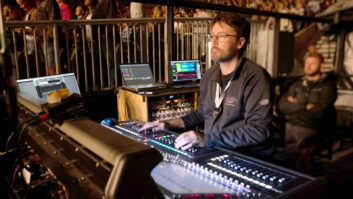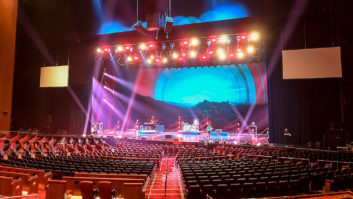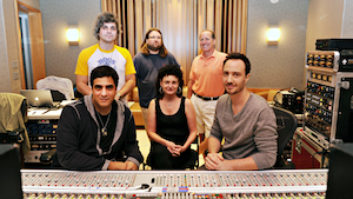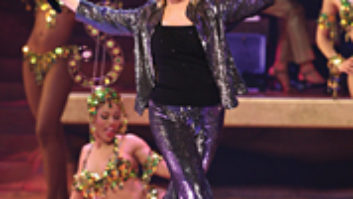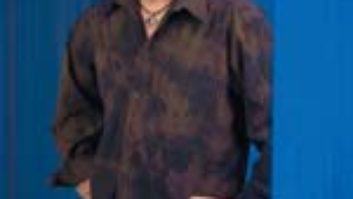Many live sound mixers are in a position to specify a preferred live console (as long as the production manager approves the budget, of course). Some mixers swear by the Midas XL4; others are partial to the Yamaha PM-4000. Soundcraft, InnovaSon, Harrison, Cadac and Crest are some names that appear on carnets and bid proposals around the world. But very few, if any, concert sound system designs call for an SSL MT Production (MTP). Perhaps that’s not surprising because, unlike most of those other boards, the MTP is designed primarily for recording and broadcast applications.
Yet, it is a 96-input, all-digital MTP that occupies the custom-built FOH paddock at Caesars Colosseum (Las Vegas), a brand-new, $100 million 4,000-seat auditorium constructed and equipped specifically for one artist — Celine Dion — who will be appearing there exclusively for the next three years. Dion will perform five days per week for 40 weeks during the year, and, with 200 shows per year at the Colosseum adding up to a potential 800,000-ticket box office, one can assume that the sound portion of the budget was more than adequate. Highlights of the installed system include the 48kHz, 24-bit-capable MTP, a 150-speaker 5.1 surround system comprising Meyer Sound self-powered cabinets, plus an extensive in-ear monitoring system for the show’s eight musicians, three backup singers and various performance artists. The enormous stage features a Diamond-Vision backdrop on the upstage wall and 100,000-lumen video projectors for front-scrim projection. When not in use for A New Day of Celine Dion, the room will be available for other productions.
Any other details on the show’s actual production would be highly speculative, because rehearsals were cloaked in secrecy until the show opened on March 27th, after press time. However, the fact that the show’s artistic director is Franco Dragone, creator of Cirque du Soliel‘s long-running and spectacular “Mystere” and “O,” should give some idea of the levels of artistic and technical accomplishment that will be on display. “If you’ve seen Dragone’s shows, there’s always something in the background, as well as the foreground,” points out FOH engineer Denis Savage. “But it’s still a Celine show with a full band, so it’s a nice integration of two worlds.”
Anyone familiar with Dion’s record as a concert artist knows her reputation for quality sound. (See Mix, January 1999 for an account of Dion’s use of the Soundcraft Broadway digital mixer.) It therefore comes as no surprise to learn that the sound design at the Colosseum was largely the result of a collaboration among Dion’s veteran sound team: FOH engineer Savage, monitor engineer Daniel Baron and system tech and SIM operator Francois “Frankie” Desjardins. Solotech of Montreal, which has supplied touring sound for Dion during the past two decades, was contracted to provide and install the equipment, in conjunction with Audio Analysts.
COLOSSAL REQUIREMENTS
The Colosseum was designed to meet an important requirement: Dion had expressed the desire that the audience be close to the stage; in fact, no seat is farther than 120 feet away from the stage, which, at 120 feet wide, 40 feet high and nearly 100 feet deep, is larger than the stage at Radio City Music Hall. In fact, the sheer size of the stage required the development of a microclimate air-conditioning system to control ventilation and humidity at the front of the stage. Arranged in a 120° fan, the audience is distributed among the generous orchestra level plus two relatively shallow balconies wrapped around the room above. The FOH mix position is centrally located on the orchestra level.
Savage has worked with Dion since early in her career and is also the managing director of Studio Piccolo, where Dion recorded several albums. “At first, I wasn’t thinking of using [the SSL MTP] at all,” Savage says. “I was recording a French artist in Paris with one of Le Voyageur’s remote trucks and the show was moved,” recalls Savage. “They said, ‘Here’s our newest truck and the assistant is great and if you’re not happy, you don’t have to pay for it.’ I was blown away by the console. It really didn’t feel like a digital desk.”
Another primary requirement for A New Day of Celine Dion was for a total surround sound experience, with a precise and controllable mix for the audience. It turned out that the MTP, last year’s TEC Award winner, was the only suitable desk that could provide a 5.1 mix of vocals layered on top of a second 5.1 band mix while also providing stereo mixes. Twelve aux sends, 12 stereo effects returns and 12 mix buses are configurable in any combinations of mono, stereo, LCR and/or surround.
As Savage explains, the dual-layer 5.1 mix is necessary because instruments and vocals need to be treated differently in a live surround mix. Whereas instruments can be placed in the mix in isolation, cueing the listener to a given location, the vocals must be widely spread. And, because of the complexity of correctly adjusting EQs and delays for such a large room, the only way to correctly balance all of the surround system zones is by playing back prerecorded tracks late at night. “The show that we’re putting together is something you could never tour with,” Savage wryly admits.
As with any high-profile theater show, production space in the house is at a premium, so the FOH board had to provide for a high number of inputs in a relatively small footprint. Because the MTP accesses its 96 stage inputs in two layers, bringing each to the surface as needed, it is effectively half the size of a comparable analog desk. And, because the MTP included studio-quality dynamics processing on every channel, its hefty price was offset by savings on unneeded equipment. “When we started adding everything up, the MTP was actually a bit cheaper than an analog desk with moving faders, plus all the outboard we would have needed for dynamics and surround panning,” Savage says. “The service we’ve gotten from SSL has been amazing. Most people don’t think about that.”
Stage inputs connect via three pairs of send-and-return “HiWay” co-ax cables, which deliver multiplexed digital signals from the stage box to the board’s processor. Each of the eight remote mic preamp stageboxes contains 12 inputs for a total of 96 inputs at the stage, of which 24 inputs are multiplexed onto one HiWay, 36 each onto the other two. The mic pre’s can be controlled remotely via Ethernet control cables in each HiWay cable set.
Savage’s outboard equipment needs are modest, largely due to the availability of excellent onboard EQ and dynamics facilities. Savage has, however, a couple of XTA SiDD processors, a Lexicon 960, a TC Electronic M-6000, two Eventide Eclipses and a TC FireworX. Each effect can be controlled from the console; patches are recalled and adjusted from SysEx commands, which map each unit’s parameters to labeled buttons and knobs on the MTP’s surface.
MEYER SURROUND SYSTEM
The elaborate sound system is made up of more than 150 Meyer speakers. Arranged in a 5-channel surround design, the system features identical eight-box line arrays of M3D speakers, which are flown as L/R sources on either side of the proscenium. The system’s sub-bass is delivered by two side-by-side columns of six M3D cardioid subwoofers flown above center stage, which are framed by two eight-box M2D columns, which are fed center-channel information and splayed to properly cover the theater’s width. UPA-1P and UPA-2P speakers placed around the sides and rear of the venue deliver rear-left and right-surround channels; underbalcony speakers are UPMs.
Ensuring proper front-fill coverage for the VIP seats in front of center stage called for a creative solution: “With a 40-foot-high proscenium, the P.A. is quite high above, and the front of the stage is very low, so to cover the front row was a challenge,” comments Savage, who used Meyer SB-2 parabolic Sound Beam speakers mounted on each side of the stage on the sidewall, facing sideways, to cover the front seats from about 100 feet. “This brings the image down so it’s not coming from directly overhead for the first few rows,” says Savage. “I think we are the first to try that, but it works extremely well.”
Because all of the Meyer speakers are self-powered, there is no need for external crossovers, but the entire system is controlled with BSS Soundweb processors, which are used to delay and equalize line-level feeds to each speaker zone. An Ethernet-based Meyer Sound RMS system provides control and monitoring facilities for all of the individual amplifiers.
MONITOR WORLD
Monitor engineer Daniel Baron has worked with Dion for the past 15 years. Located offstage in a room one flight up, Baron mixes on a Yamaha PM-1D, which he augments with a Lexicon 960, four Lexicon PCM91s and four Eventide Eclipses. All cast members use Sennheiser wireless in-ear monitors and microphones, including the SKM-5000 with Neumann MK-105 cartridges for vocals.

